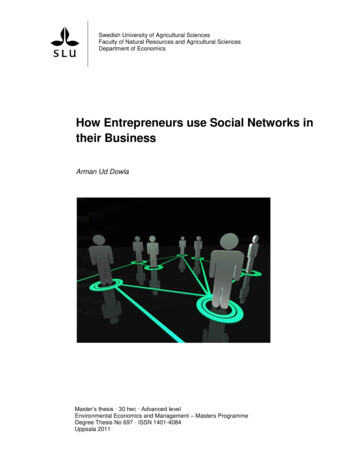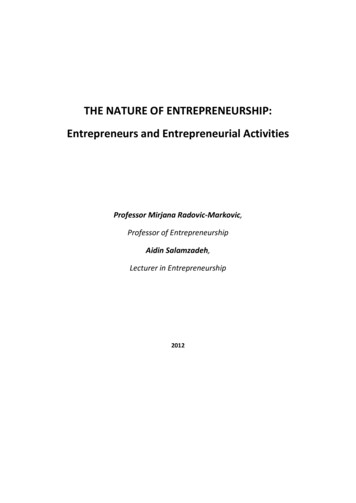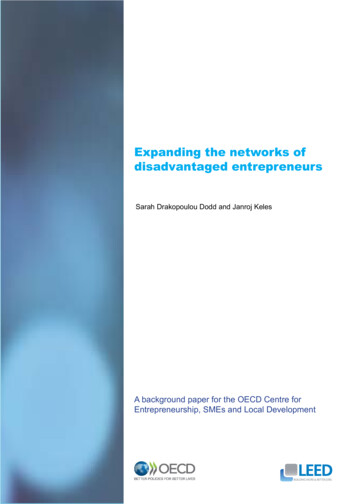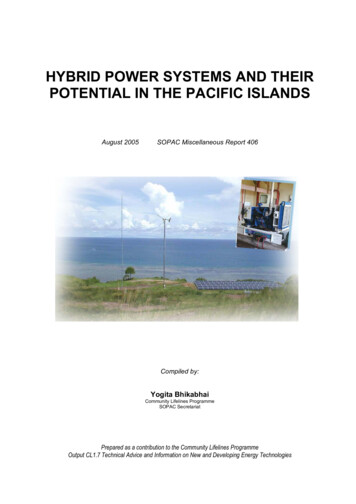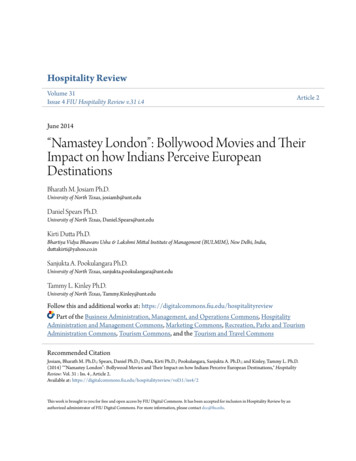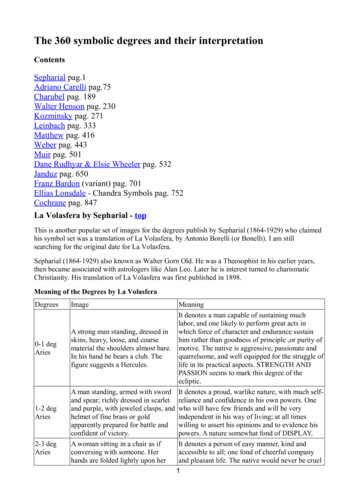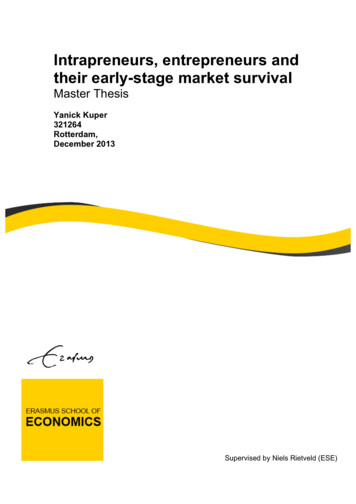
Transcription
Intrapreneurs, entrepreneurs andtheir early-stage market survivalMaster ThesisYanick Kuper321264Rotterdam,December 2013Supervised by Niels Rietveld (ESE)
INTRAPRENEURS, ENTREPRENEURS AND THEIREARLY-STAGE MARKET SURVIVALMaster Thesisto obtain the degree of Master of Science in Economics and Business Economics,specializing in Entrepreneurship and Strategy EconomicsMSc Economics and Business – Master in Entrepreneurship and Strategy EconomicsERASMUS UNIVERSITY ROTTERDAMErasmus School of EconomicsDrafted byYanick Kuper321264Supervised by Niels Rietveld (ESE)December 20132
AbstractThis article employs the Panel Study of Entrepreneurial Dynamics II (PSED II) in thestudy of a nationally representative sample of American entrepreneurs andintrapreneurs and their early-stage firm survival during the first six-years of startup.Building on an expansive theoretical framework this article empirically examines andinvestigates whether it is intrapreneurs or entrepreneurs that have the longest earlystage market survival. Results also reveal the factors (i.e. entrepreneurial capital anddemographics) that are associated with venture survival.While numerous fields of research have dedicated their time and energy intoexploring the concepts of entrepreneurship and intrapreneurship, studies have, untilnow, avoided the examination of early-stage survival of intrapreneurial andentrepreneurial start-up efforts. This is in part due to the fact that there had been noavailable dataset to explore such a topic (Parker, 2011). The arrival of the PSED IIdataset in 2011 changed this. Consequently, this is one of the first papers to be able topresent empirical evidence comparing intrapreneurial and entrepreneurial start-upefforts. To realize this, the PSED II dataset was empirically analyzed using simplelogistic and multinomial logistic regressions.Results indicate that intrapreneurs in a corporate work environment are morelikely to experience early-stage firm survival compared to entrepreneurs. In additionto this, there are several demographic factors and entrepreneurial capital factors thatare also associated with venture survival. These apply to both intrapreneurs andentrepreneurs. Results show that age, race and an individuals’ level of extroversion, interms of being open to business opportunities, increase the likelihood for early-stageintrapreneurial and entrepreneurial firm survival. Based on these findings severalstrategic implications and recommendations will be provided.KEYWORDS: Entrepreneurship, Intrapreneurship, Venture Creation, Early-stagesurvival, Entrepreneurial capital, Demographic effects3
AcknowledgementsCompletion of this master’s thesis was made possible thanks to the contributions ofseveral people. Without their backing and guidance I would not be where I am today.Therefore, I would like to thank the following people.First and foremost I would like to offer my heartfelt gratitude and thanks tomy thesis advisor Niels Rietveld (MSc). His constant and incredible support,motivation, enthusiasm, knowledge and patience were key to making this researchpossible. Without the time and effort he personally put into helping me through thisentire process, this thesis would not have been completed. One could not think of abetter or friendlier supervisor. My profoundest thanks Niels.Additionally, I would also like to thank Dr. Jolanda Hessels for her insightfulcomments and pressing questions as co-reader.I would also like to thank my fellow classmates for the fun year we hadtogether. The times spent working as a team trying to make our assignment deadlinesand the effort we put into helping each other out in times of need, also played acrucial role in getting me where I am.Lastly, I would like to thank my parents Brigitte Kuper-Andersen and HenryKuper for their unconditional love and support. You have been the pillars in my lifeand your direct and indirect contributions have played a large role in helping methroughout my studies at University.4
Table of Contents1INTRODUCTION 62LITERATURE REVIEW . 102.1ENTREPRENEURSHIP . 102.2INTRAPRENEURSHIP .112.3ENTREPRENEURSHIP VERSUS INTRAPRENEURSHIP .132.4ENTREPRENEURIAL CAPITAL .152.5DEMOGRAPHIC CHARACTERISTICS .17EMPIRICAL ANALYSIS .253.1DATA AND SAMPLE .253.2VARIABLE ANALYSIS .283.3METHOD 32RESULTS 354.1OVERALL LOGISTIC REGRESSION 354.2YEARLY FOLLOW-UP DATA . 384.3ROBUSTNESS CHECKS .34541CONCLUSION 475.1GENERAL DISCUSSION . 475.2IMPLICATIONS .5.3LIMITATIONS AND FUTURE DIRECTIONS . 55526REFERENCES . 587APPENDIX . 655
1IntroductionOver three decades of research has shown that entrepreneurship can go one of twoways. One can either attempt to tackle the entrepreneurial process independently or goat it within an already existing organization (Hellman, 2007; Parker, 2011). This hasresulted in two separate definitions to help distinguish between independent ‘external’entrepreneurship and internal entrepreneurship. The first is simply defined as‘entrepreneurship’, and is seen as the act of creating a new venture externally, outsidean existing organization (Parker, 2011). The latter, on the other hand, has been coined‘intrapreneurship’ and is defined as corporate venturing (the creation of a new venturewithin an existing organization) (Pinchot, 1985; Sharma and Chrisman, 1999). Yet,while many authors have managed to define and tout the importance of bothentrepreneurship and intrapreneurship (Pinchot, 1985; Hornsby, Kuratko and Zahra,2002), the literature comparing both concepts has, until recently, been relativelytheoretical and anecdotal in nature. In fact, much of the existing literature lackscompelling empirical evidence comparing the contributions of entrepreneurship andintrapreneurship to organizational performance (Zahra, 1991). While there have beenvarious attempts to fill this gap in literature (Zahra and Covin, 1995; Parker, 2011;Felício, Rodrigues and Caldeirinha, 2012), there is still much more to be learned andcompared about entrepreneurship and intrapreneurship in general. One such topicrelates to comparing the early-stage survival of intrapreneurial and entrepreneurialstart-up efforts. Early-stage in this case, implies the first six-years in a firms’ businesscycle (Reynolds and Curtin, 2011). As such, this present article investigates moreclosely, whether it is the intrapreneurial or the entrepreneurial start-up efforts thathave a longer early-stage survival rate. Moreover, and most importantly, it alsoexamines the factors (i.e. entrepreneurial capital and demographics) that influencethese survival rates.Previous research has managed to pinpoint several reasons as to whyintrapreneurial start-up efforts might be deemed as the less effective of the two. Theseinclude “their increased agency costs, which affect contracting between employeesand employers; transferable human capital; and organizational limitations ofincumbent firms such as bureaucracy and rigid routines” (Henderson, 1993; Antonand Yao, 1995; Klepper, 2002; Helfat and Lieberman, 2002 in Parker, 2011: 20).6
However, existing research is still limited in terms of being able to provide empiricalevidence that both supports these statements and manages to compare it toentrepreneurial start-up efforts (Parker, 2011). In fact, studies have yet to examine theearly-stage survival rates of intrapreneurial and entrepreneurial start-up efforts, aswell as what kind of factors and conditions are involved. Instead, existing papers onthe subject have been mainly concerned with linking corporate entrepreneurialactivity to strategic management (Burgelman, 1983); the benefits of freedom in firmperformance for entrepreneurs and intrapreneurs (Ross and Unwalla, 1986); theperformance of new spinoff firms when compared to parent firms (Gompers, Lernerand Scharfstein, 2005; Klepper and Thompson, 2006); and characteristics ofintrapreneurs (Fayolle, 2004; Terracciano, McCrae, Brant and Costa, 2005).Consequently, building upon current theoretical arguments, this article aims toempirically examine and test several hypotheses as to whether it is intrapreneurs orthe entrepreneurs that have the longest early-stage firm survival. Furthermore, thegoal is to also dive deeper into the factors that may affect the survival of these firms inthe first six years of their existence. In examining factors such as an individual’sentrepreneurial capital and demographic characteristics, a more comprehensive look isprovided as to why certain intrapreneurial or entrepreneurial start-ups survive forlonger periods of time. Consequently, the following paper utilizes data from arelatively large and representative publicly available survey of American adults, thePanel Study of Entrepreneurial Dynamics II (PSED II). Designed with the purpose toimprove the scientific understanding of how and why people start a business, itcontains a rich array of explanatory variables about U.S.-based individuals who areeither intrapreneurs or entrepreneurs (Reynolds and Curtin, 2007). It includesinformation about their personal characteristics; demographics; competencies;products; the processes they undertake in the business start-up process; and theorganizational environments they operate in (Aldrich, 1999; Menzel, Aaltio and Ulijn,2007). The PSED II also contains information about existing intrapreneurs andentrepreneurs who wish to start an additional new venture. Moreover, setting aside itsincredibly detailed scope, a further crucial aspect of the PSED II dataset is the factthat it is a panel study that studied individuals from September 2005 until April 2011.Its multi-year tracking of individuals starting new businesses, whereby they wereidentified prior to the launch of their firms and are tracked through gestation, launch,7
and to the eventual growth or death of the firm, makes this the ideal dataset for thestudy of early-stage firm survival (Parker and Belghitar, 2006).The present paper therefore advances on previous entrepreneurial andintrapreneurial studies by making two main contributions to the literature. First, thisarticle enriches existing literature, as it is one of the first of its kind to presentempirical evidence comparing the early-stage survival of intrapreneurial andentrepreneurial start-up efforts. In addressing this gap using a comparativequantitative inquiry through the utilization of the recently released U.S.-based PanelStudy of Entrepreneurial Dynamics II (PSED II) data, this paper will expand upon thelittle empirical work that exists on this topic. Knowing that, until recently, the scarcityof such a dataset made it virtually impossible to do such a comparative analysis, thispaper provides a novel contribution to the existing literature.Second, this article aims to build upon the foundation set in Parker’s (2011)empirical study. His pioneering work using the PSED II dataset in the exploration of“the factors that determine whether new business opportunities are exploited byintrapreneurship or entrepreneurship” provides a sound footing for this papers inquiryinto examining how entrepreneurial capital and demographic factors affect the earlystage survival of intrapreneurial and entrepreneurial start-up efforts (p.19). Inaddition, with the recent arrival of the complete PSED II panel study earlier this year,this study will most certainly advance upon his earlier work as their limitationsincluded the fact that they lacked the time horizons in order to better and moretransparently follow entrepreneurs and their outcomes (Parker and Belghitar, 2006;Parker, 2011). Thus by tracing his footsteps, increased empirical and theoreticalevidence can be provided to the existing set of intrapreneurial and entrepreneurialliterature. Lastly, considering the fact that, at this moment in time, he is one of the fewpublished author that has managed to utilize the PSED II dataset it only seems wise toexpand on this existing knowledge set. Utilizing this knowledge base allows for amore expansive and detailed insight into this research subject, while also allowing thispaper to provide a novel angle into this interesting economic research topic.In what follows, section two will present the literature and develop ngtoentrepreneurshipand8
intrapreneurship, entrepreneurial capital, demographics as well as early-stage firmsurvival. The section that follows dives into the empirical analysis of the dataset,detailing the data and sample, the key explanatory and control variables as well as themethod that was utilized. The fourth section outlines the results from the simplelogistic model as well as the multinomial logistic regressions. Section five thenconcludes by discussing the results in relation to existing literature as well as the mostimportant findings and limitations.9
2Literature ReviewNumerous fields of research have dedicated their time and energy into exploring theconcepts of entrepreneurship and intrapreneurship. Although past literature covers awide spectrum of theories and concepts, the conceptual framework adopted here willkeep its focus on two major themes. These themes are entrepreneurial capital anddemographic characteristics. Nonetheless, before these themes are elaborated upon itis important to highlight what is known, and what is not known within theentrepreneurial and intrapreneurial academic spheres. Consequently, this review willfirst elaborate on existing entrepreneurial literature with the aim of giving a brief andcondensed overview of what is known. The same will then be done using theintrapreneurial perspective, which will then be followed by a synopsis of existingresearch comparing intrapreneurship and entrepreneurshi
KEYWORDS: Entrepreneurship, Intrapreneurship, Venture Creation, Early-stage survival, Entrepreneurial capital, Demographic effects . 4 Acknowledgements Completion of this master’s thesis was made possible thanks to the contributions of several people. Without their backing and guidance I would not be where I am today. Therefore, I would like to thank the following people. First and
